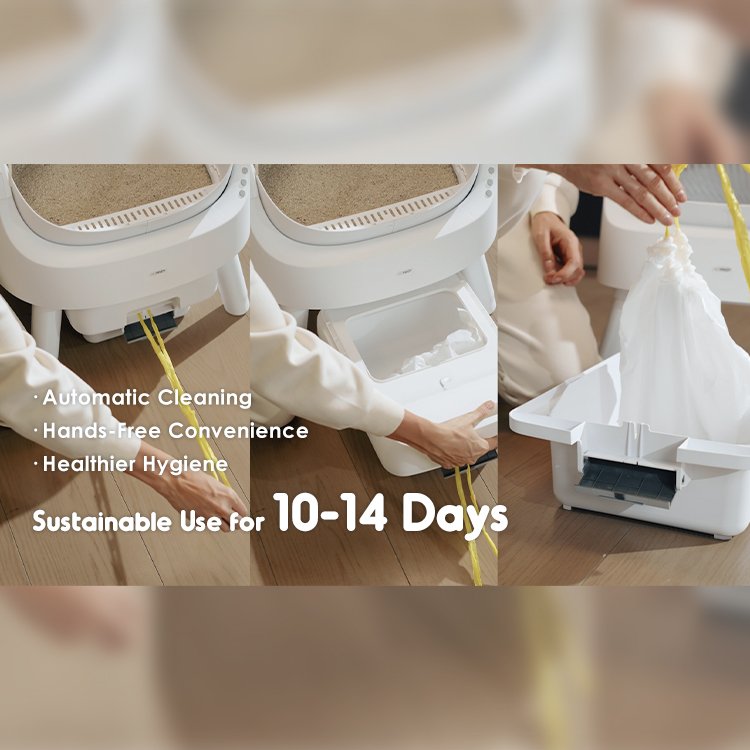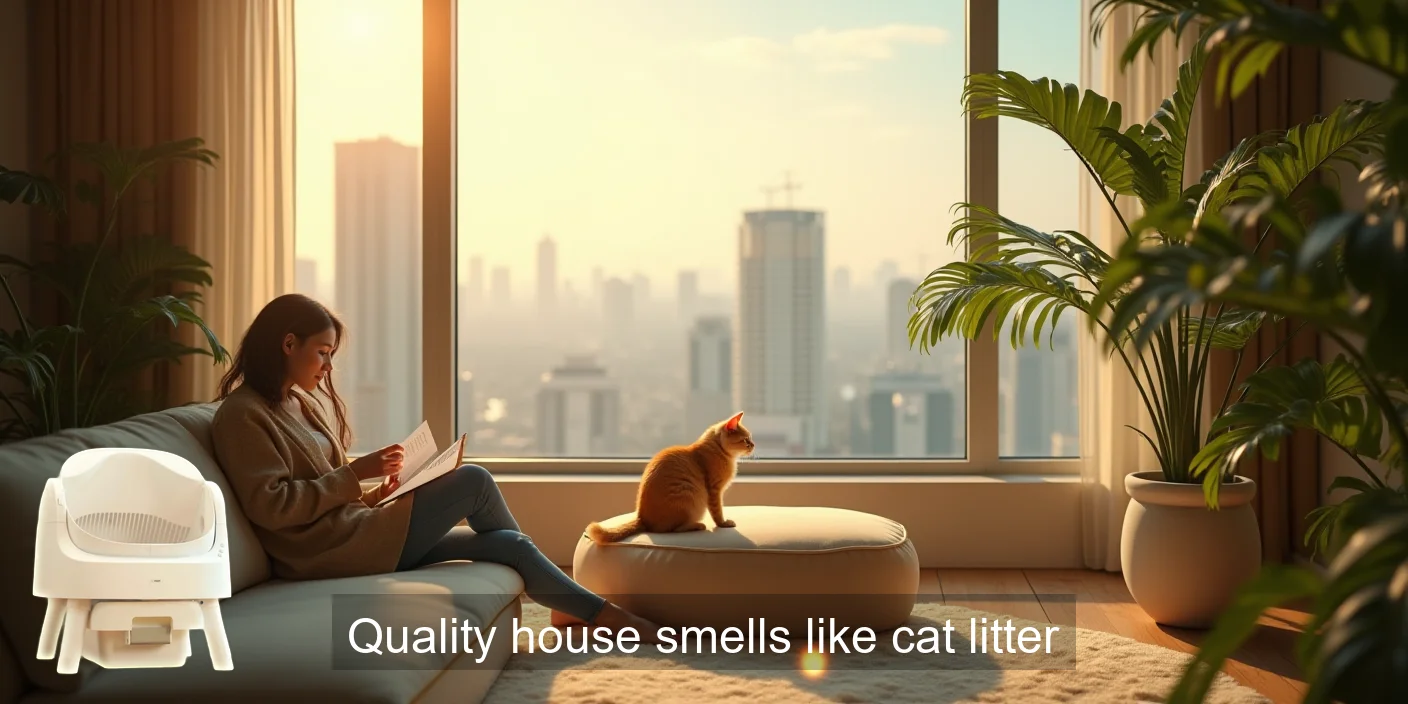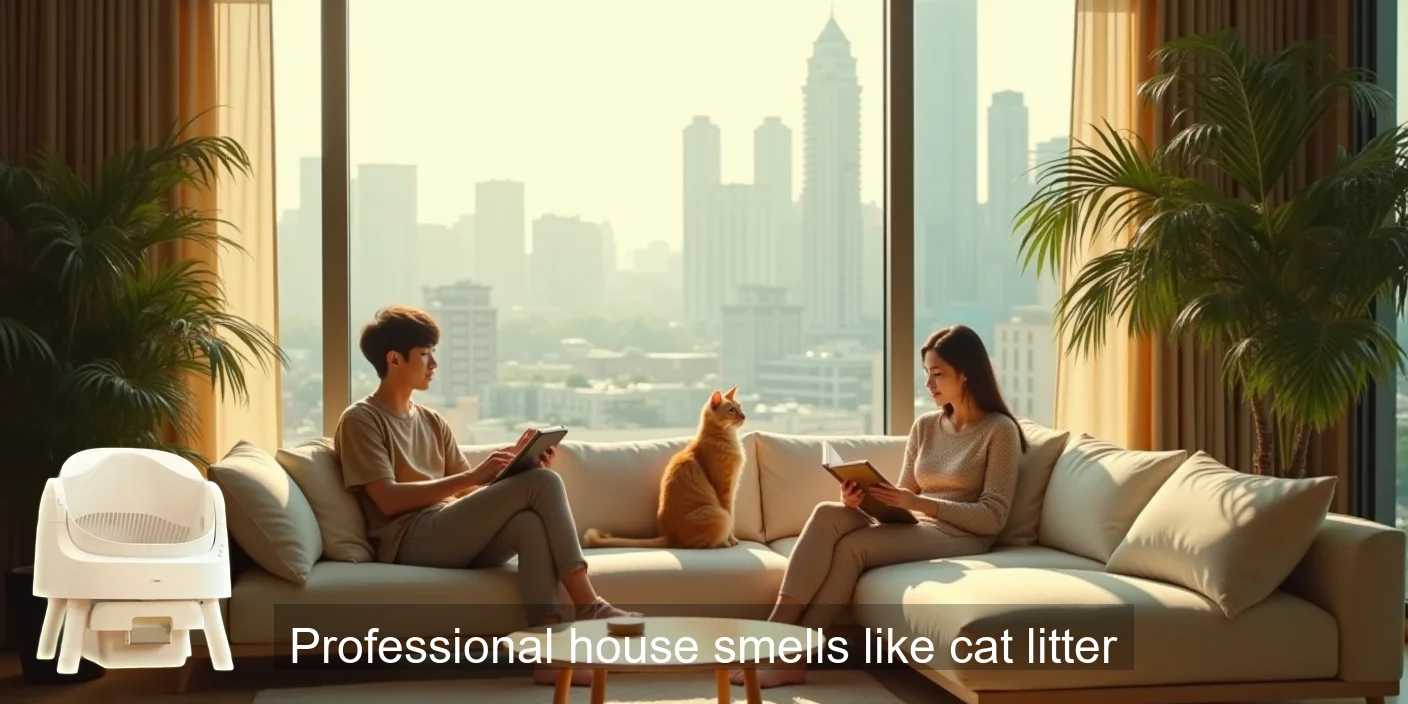House Smells Like Cat Litter? Conquer Cat Odor Control!

1. Understanding the Source of the Smell
1.1. The Science Behind Cat Litter Odor
Cat litter odor is primarily caused by ammonia, a byproduct of urine decomposition, and bacteria that thrive in the litter box environment. Feces also contribute to the smell, especially if not removed promptly. Understanding the chemical processes involved is crucial for effective odor control.
- Ammonia is a major contributor to the pungent smell.
- Bacteria break down waste, releasing foul odors.
- The type of litter significantly impacts odor control.
FAQ: Understanding Cat Litter Odor
Q: Why does my cat’s urine smell so strong?
Odor Sources
A: Cat urine is naturally concentrated, and the ammonia produced during decomposition contributes to the strong odor. Diet and hydration levels can also play a role.
Q: What role do bacteria play in cat litter odor?
Banishing Cat Litter Odor
1. A lingering, unpleasant ammonia scent hangs in the air, a clear indication of neglected cat litter. The smell is overpowering and difficult to ignore.
That Litter Box Smell
2. The house smells strongly of cat urine and used litter, a sharp, pungent odor that permeates every room. Cleaning is urgently needed.
Conquer Cat Litter Smell
3. A subtle but persistent odor of cat litter permeates the air, hinting at a larger cleaning issue that needs immediate attention.
No More Litter Box Stink
4. The distinct, sharp tang of ammonia stings the nostrils – a telltale sign of overflowing or improperly maintained cat litter boxes.

Q: Does the type of cat food affect litter box odor?
A: Yes, a diet high in protein can lead to increased ammonia production in urine, potentially worsening the odor.
Practical Advice: Monitor your cat’s diet and water intake. A balanced diet and adequate hydration can help reduce the concentration of urine and minimize odor.
Statistic: Studies show that litters with activated carbon can reduce ammonia emissions by up to 70%.
1.2. Common Mistakes Leading to Odor Problems
Many cat owners inadvertently contribute to odor problems through common mistakes, such as infrequent scooping, using the wrong type of litter, or neglecting to clean the litter box itself. Identifying and correcting these errors is essential for effective odor control.
- Not scooping the litter box frequently enough.
- Using a litter that doesn’t effectively absorb odors.
- Failing to regularly clean the litter box itself.
FAQ: Common Mistakes
Q: How often should I scoop the litter box?
A: Ideally, you should scoop the litter box once or twice daily to remove solid waste and clumps of urine.
Q: How often should I completely change the litter?
A: Completely change the litter every 2-4 weeks, depending on the type of litter and the number of cats using the box.
Q: Can I use scented litter to mask the odor?
A: Scented litter can sometimes mask the odor, but it can also be irritating to some cats. Opt for unscented, odor-absorbing litter instead.
Q: What kind of cleaner should I use to clean the litter box?

A: Use mild soap and water. Avoid harsh chemicals or scented cleaners, as they can be harmful to your cat.
Practical Advice: Set a daily reminder to scoop the litter box. This simple habit can make a significant difference in odor control.
Statistic: A survey found that cat owners who scoop the litter box daily report 50% less odor compared to those who scoop less frequently.
2. Choosing the Right Litter and Litter Box
2.1. Types of Litter and Their Odor Control Properties
The type of litter you choose plays a crucial role in odor control. Clumping clay litter, crystal litter, and natural litters (such as wood or paper) each have unique properties that affect their ability to absorb odors and moisture.
- Clumping clay litter is a popular and affordable option.
- Crystal litter offers superior odor control due to its high absorbency.
- Natural litters are environmentally friendly but may require more maintenance.
FAQ: Litter Types
Q: What is the best litter for odor control?
A: Crystal litter generally offers the best odor control, but clumping clay litter with added odor absorbers can also be effective.
Q: Is natural litter as effective as clay litter for odor control?
A: Natural litters vary in their odor control properties. Look for natural litters specifically designed for odor absorption.
Q: How do I transition my cat to a new type of litter?
A: Gradually mix the new litter with the old litter over a period of several days to allow your cat to adjust.
Practical Advice: Experiment with different types of litter to find one that your cat likes and that effectively controls odor in your home.
Statistic: A study showed that 60% of cat owners who switched to crystal litter reported a significant improvement in odor control.
2.2. Litter Box Design and Placement
The design and placement of the litter box can also impact odor control. Covered litter boxes can help contain odors, while open litter boxes provide better ventilation. The location of the litter box should be in a well-ventilated area away from high-traffic zones.
- Covered litter boxes can help contain odors but require regular cleaning.
- Open litter boxes provide better ventilation but may allow odors to escape.
- The litter box should be placed in a well-ventilated area.
FAQ: Litter Box Design and Placement
Q: Should I use a covered or open litter box?
A: Consider your cat’s preferences and your odor control needs. Covered boxes contain odors better, but some cats prefer open boxes.
Q: Where is the best place to put the litter box?
A: Place the litter box in a quiet, well-ventilated area away from your cat’s food and water.
Q: How many litter boxes should I have?
A: The general rule is one litter box per cat, plus one extra.

Practical Advice: Experiment with different litter box designs and placements to find what works best for your cat and your home.
Statistic: Studies show that cats are more likely to use a litter box that is clean and easily accessible.
Banishing Cat Litter Odor
1. A lingering ammonia tang hangs heavy in the air, a stark reminder of uncleaned litter boxes. The smell is overpowering, clinging to fabrics and surfaces.
Conquer That Litter Box Smell
2. That distinctive, pungent odor of cat waste permeates Block 2. Ventilation seems inadequate, leaving the smell cloying and unpleasant.
Fresh Air, No Cat Smell
3. The air in Block 2 is thick with the scent of feline waste, a strong, almost sickeningly sweet ammonia smell. It’s clearly a recurring problem.
Eliminate Cat Litter Stink
4. A sharp, unpleasant odor assaults the nostrils upon entering Block 2 – the unmistakable stench of neglected cat litter boxes. It’s difficult to ignore.
Your Pets Deserves This Litter Box!
3. Advanced Odor Control Techniques
3.1. Air Purifiers and Odor Absorbers
Air purifiers with HEPA filters and activated carbon can effectively remove odors and allergens from the air. Odor absorbers, such as baking soda or activated charcoal, can be placed near the litter box to neutralize odors.
- Air purifiers can remove odors and improve air quality.
- Odor absorbers neutralize odors at the source.
- Essential oil diffusers can mask odors but should be used with caution around cats.
FAQ: Air Purifiers and Odor Absorbers
Q: What type of air purifier is best for cat litter odor?
A: Air purifiers with HEPA filters and activated carbon are most effective at removing odors and allergens.
Q: Are essential oils safe to use around cats?
A: Many essential oils are toxic to cats. Use caution and consult with your veterinarian before using essential oil diffusers.
Q: How often should I replace the filters in my air purifier?
A: Replace the filters according to the manufacturer’s instructions, typically every 3-6 months.
Practical Advice: Place an air purifier near the litter box to continuously remove odors from the air. Sprinkle baking soda in the bottom of the litter box before adding fresh litter to absorb odors.
Statistic: Studies show that air purifiers with activated carbon can reduce airborne odors by up to 80%.
3.2. Deep Cleaning and Stain Removal
Accidents happen, and cat urine can leave lingering odors and stains. Deep cleaning carpets, upholstery, and other surfaces with enzymatic cleaners is essential for removing these odors and preventing recurrence. Regular cleaning of the litter box area can also help prevent odor buildup.
- Enzymatic cleaners break down the organic matter that causes odors and stains.
- Steam cleaning can deep clean and sanitize carpets and upholstery.
- Regular cleaning of the litter box area prevents odor buildup.
FAQ: Deep Cleaning and Stain Removal
Q: What are enzymatic cleaners?
A: Enzymatic cleaners contain enzymes that break down organic matter, such as urine and feces, eliminating odors and stains.
Q: How do I use an enzymatic cleaner?
Odor Metrics
A: Follow the manufacturer’s instructions. Typically, you’ll need to saturate the affected area and allow the cleaner to sit for a specified time before blotting it up.
Q: Can I use bleach to clean cat urine stains?
A: No, bleach can react with ammonia in cat urine to create toxic fumes. Use enzymatic cleaners instead.
Practical Advice: Keep enzymatic cleaner on hand for immediate cleanup of accidents. Regularly clean the litter box area with a mild detergent and water.

Statistic: Studies show that enzymatic cleaners are up to 90% effective at removing cat urine odors and stains.
4. Addressing Underlying Health Issues
4.1. Urinary Tract Infections and Other Medical Conditions
Sometimes, a strong cat litter odor can be a sign of an underlying health issue, such as a urinary tract infection (UTI) or kidney disease. These conditions can affect the composition and concentration of urine, leading to increased odor. Consult with your veterinarian if you notice a sudden change in your cat’s urine odor or behavior.
- UTIs can cause a stronger, more pungent urine odor.
- Kidney disease can alter the composition of urine, leading to increased odor.
- Diabetes can cause a sweet or fruity urine odor.
FAQ: Health Issues and Odor
Q: How can I tell if my cat has a UTI?
A: Symptoms of a UTI include frequent urination, straining, and blood in the urine. Consult with your veterinarian for diagnosis and treatment.
Q: Can kidney disease affect urine odor?
A: Yes, kidney disease can alter the composition of urine, leading to increased odor.
Q: What should I do if I notice a change in my cat’s urine odor?
A: Consult with your veterinarian to rule out any underlying health issues.
Practical Advice: Monitor your cat’s urination habits and consult with your veterinarian if you notice any changes. Regular checkups can help detect and treat underlying health issues early.
Statistic: Studies show that up to 10% of cats will develop a UTI at some point in their lives.
4.2. Diet and Hydration
A cat’s diet and hydration levels can significantly impact urine concentration and odor. A diet high in protein can lead to increased ammonia production, while inadequate hydration can result in more concentrated urine. Ensure your cat has access to fresh water at all times and consider feeding a balanced diet formulated for optimal urinary health.
- A high-protein diet can increase ammonia production.
- Inadequate hydration can result in more concentrated urine.
- Poor-quality food can lead to digestive issues and altered urine composition.
FAQ: Diet and Hydration
Q: How can I encourage my cat to drink more water?
A: Provide multiple water sources, use a water fountain, and offer wet food.
Q: What type of cat food is best for urinary health?
A: Look for cat food formulated for urinary health, with balanced protein levels and added nutrients to support kidney function.
Q: Should I feed my cat wet or dry food?
Banishing Cat Litter Odors
1. A lingering, dusty scent of used cat litter hangs in the air, a subtle but persistent reminder of feline inhabitants. Cleaning is clearly overdue.
Conquer That Litter Box Smell
2. The faint ammonia tang of cat litter mixes unpleasantly with other household odors, creating a strangely pungent and unwelcome atmosphere.
No More Cat Litter Stink
3. Despite attempts at cleaning, a stubborn, earthy smell reminiscent of cat litter clings to the carpets and drapes.
Fresh Air, No Cat Smell
4. An overwhelming aroma of cat litter dominates the room, a strong, unpleasant scent that immediately alerts visitors to the presence (and possibly neglect) of a pet.
A: Wet food can help increase your cat’s water intake, which can be beneficial for urinary health.
Practical Advice: Provide multiple water bowls around your home and consider adding wet food to your cat’s diet. Consult with your veterinarian about the best diet for your cat’s individual needs.
Statistic: Studies show that cats who eat wet food have a lower risk of developing urinary tract problems.

Conclusion
Conquering cat litter odor requires a multi-faceted approach, from understanding the source of the smell to implementing effective odor control techniques. By choosing the right litter and litter box, practicing regular maintenance, utilizing air purifiers and odor absorbers, and addressing any underlying health issues, you can create a fresh, inviting home for both you and your feline friend. Remember that consistency is key – regular scooping, cleaning, and monitoring your cat’s health will make a significant difference in odor control. Don’t let cat litter odor take over your home; take control and enjoy a clean, pleasant environment. Now that you’re armed with this knowledge, it’s time to take action! Start by evaluating your current litter and litter box setup, and consider implementing some of the strategies outlined in this guide. Your nose (and your cat) will thank you!
Ready to say goodbye to cat litter odor? Browse our selection of odor-absorbing litters and air purifiers today! Shop Now!


